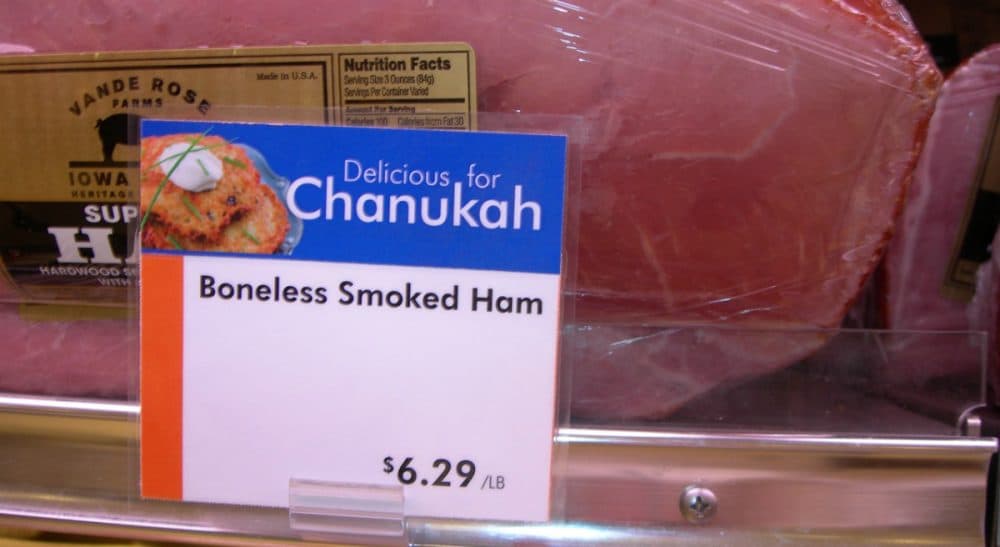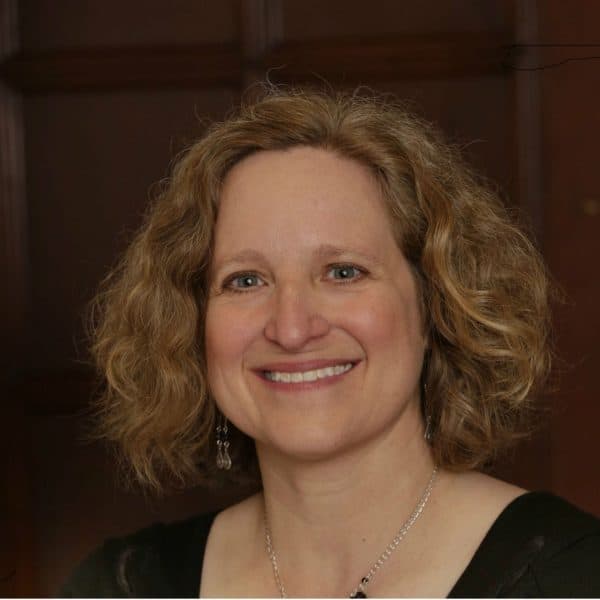Advertisement
Commentary
The Hanukkah Ham, And Other Morsels Of Religious Ignorance

An apron-clad test cook stood grinning behind a sign, “Hanukkah treats,” in an open kitchen area in a Whole Foods in suburban Boston. In pursuit of new recipes, I checked out the samples.
My face fell. “These are healthy, no sugar,” the cook offered, and added that the pineapples were dipped in honey. Another treat was a no-sugar chocolate truffle, and a third was an apple crumble, also with honey.
“What do these have to do with Hanukkah?” I asked as I tasted one of the truffles and hid a grimace. It needed sugar.
'What do these have to do with Hanukkah?' I asked as I tasted one of the truffles and hid a grimace. It needed sugar.
“Apples and honey,” she answered.
“Apples and honey? That has to do with Rosh Hashanah,” I said as I gamely tried a pineapple.
She looked chagrined. “Oh,” she said. “What are typical Hanukkah treats?”
Having grown up in a fairly secular Jewish household and become closer to my faith later in life, I was about to give a lesson on Hanukkah cuisine, such as it is. I explained that, traditionally at Hanukkah, Jews make foods fried in oil. I didn’t go into the bigger explanation because I needed to shop, but Jews fry food, like potato pancakes or donuts, to commemorate aspects of the Hanukkah story. We use sugar — lots of it -- on those donuts, which, typically, are jelly-filled.
The Hanukkah story centers on the eventual triumph of the Maccabees, a group of Jewish fighters, over King Antiochus and the Syrian Greek army. At one point, soldiers ransacked the Jews’ temple in Jerusalem. When the Maccabees entered the temple, it appeared that there was no oil left to light a special lamp known as the eternal light. But, according to early Jewish writings, the Maccabees found one jar of oil, enough for eight days – the length of Hanukkah, also known as the Festival of Lights.
Advertisement
I felt like the Hanukkah police. But I suggested she might want to turn her sign around, lest she frustrate others hunting for Hanukkah recipes. She agreed. Now, the sign just advertised healthy, no-sugar treats.
This wasn’t the first time a commercial enterprise goofed in an attempt to recognize Hanukkah. A Lord & Taylor Hanukkah greeting in last Sunday’s New York Times sparked jokes on social media and in Jewish publications. Above an English greeting of Happy Hanukkah, the ad had three Hebrew words meant to mean Happy Hanukkah holiday. But the wrong Hebrew consonant in three places meant that the ad instead read, in this approximate translation: “to the tag of her earlobe that died.”
Inevitably, every year around Hanukkah, a photo of a tony Greenwich Village grocer’s mistake from 2007 shows up on Jewish friends’ Facebook posts: “Delicious for Chanukkah” announces a sign in front of a display of ham, a non-Kosher food that observant Jews do not eat.
This year, I’ve spotted macaroons and matzoh meal, usually eaten or used at Passover, in grocery store Hanukkah displays. A Washington Post columnist ripped into a Foggy Bottom Whole Foods in 2011 for the matzoh mistake, and the grocery promptly tweeted an apology. My husband recently recounted how the restaurant in his previous employer’s company cafeteria put out matzoh at Yom Kippur, a day of fasting and atonement. It’s a Jewish holiday. Let’s eat matzoh, right? Wrong, unless it’s Passover.
Such encounters affirm the ignorance many Americans have about religions, but they also show good intentions.
Back at my local Whole Foods, I appreciated the cook’s attempt to recognize Hanukkah, which started on December 6. I wish she had gotten it right, not just on behalf of Jews, but for non-Jewish customers, too, even if Hanukkah is only a minor religious holiday for Jews.
When given a quiz about other religions, adults age 18 and over get half of 32 questions right, according to the Pew Research Center’s U.S. Religious Knowledge survey. Americans do well on questions about Christianity, with 71 percent answering correctly that Jesus, according to the Bible, was born in Bethlehem. We falter more on non-Christian religions. Fewer than half of Americans know that the Dalai Lama is Buddhist or that the Jewish Sabbath begins on Friday.
It’s a Jewish holiday. Let’s eat matzoh, right? Wrong, unless it’s Passover.
Schools, given state standards requiring the study of world religions as part of history and geography, already work to fill the gap in ignorance for the next generation. Celia Golod, who took a sixth-grade world religions course at Wellesley Middle School, saw the effect of the course two years later, when she was in a world foods class. As a homework assignment to make food connected to students’ culture, Celia brought in matzoh ball soup. Her classmates said to her with excitement, “Oh, you eat this on Passover, right?” Celia said she felt more special in that moment and prouder to be a Jew.
But what do we do about adults? How do we make up for the education most of us never had about other religions? In a way, the Whole Foods cook gives us a model. Rather than recoil when confronted with her error, she asked questions. She offers a solution for anyone, companies included, interested in acknowledging the diversity of our world. Rather than guess about another religion’s tradition, just ask.
